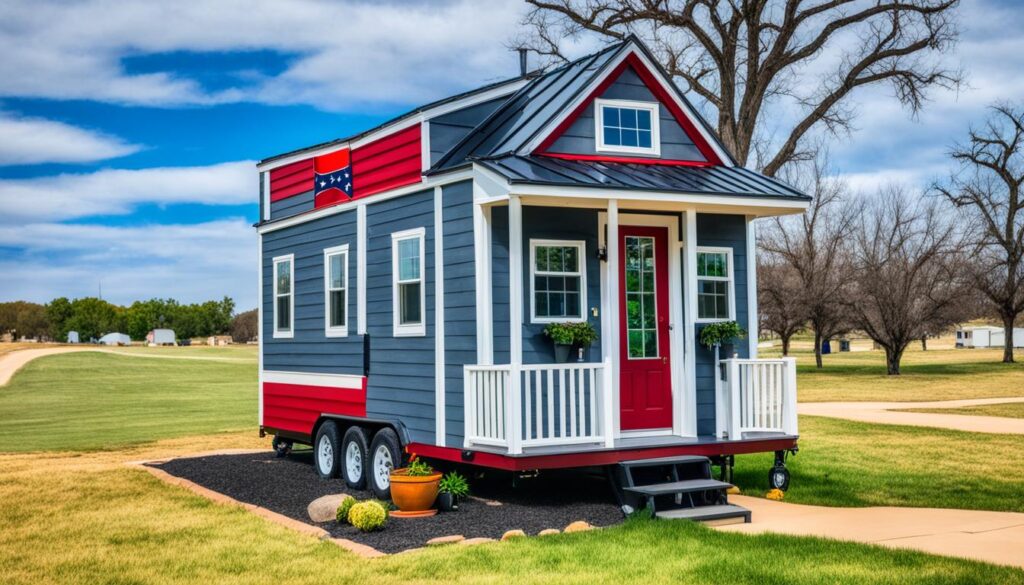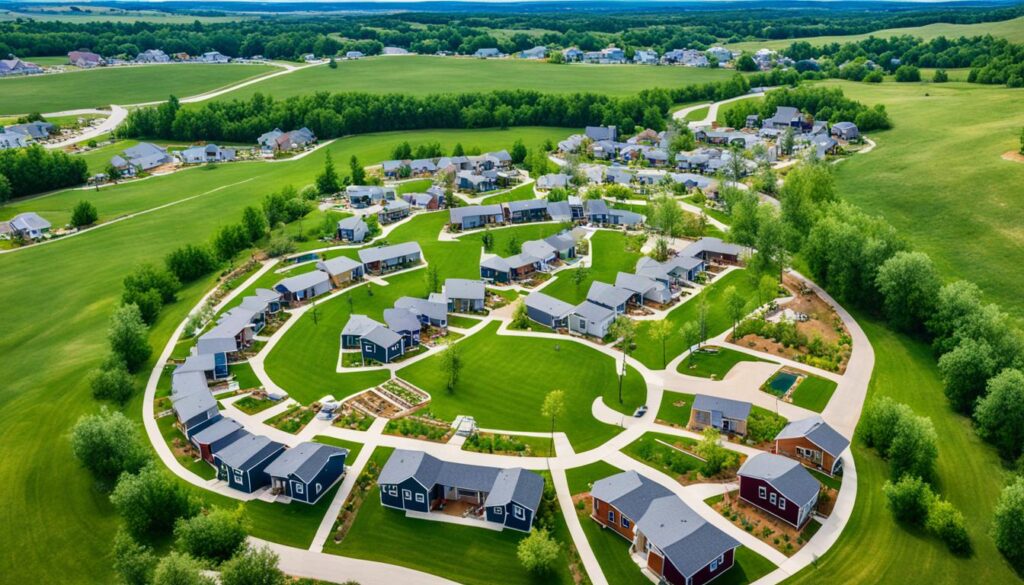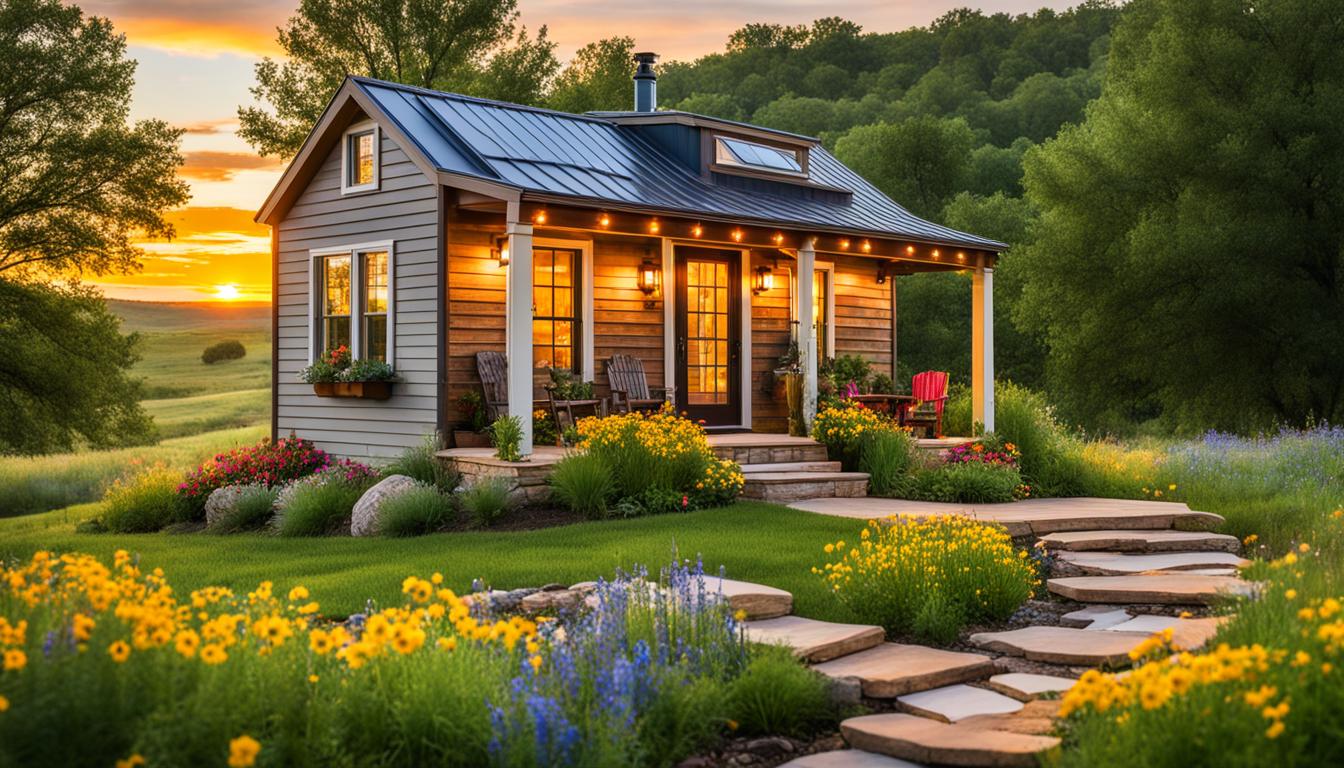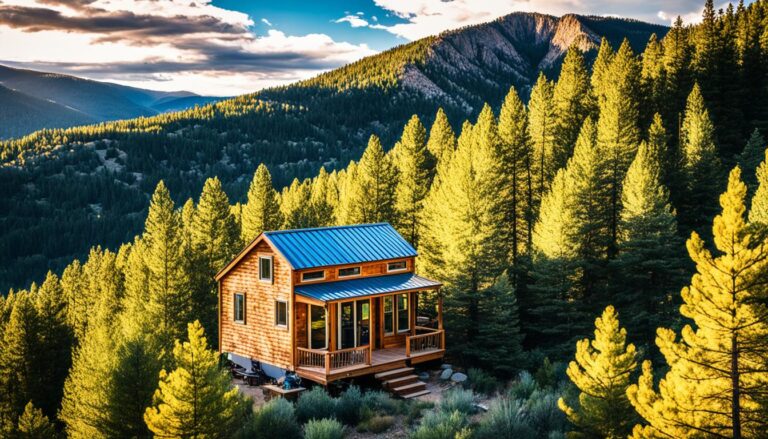Tiny House Sites in Oklahoma – Placement Guide
Did you know that the rules and regulations for placing a tiny house in Oklahoma vary by county? While some counties are welcoming towards tiny homes, others have strict zoning laws that restrict their placement. Before investing in a property or building a tiny home, it is crucial to research which counties in Oklahoma allow tiny houses. Understanding the placement laws and regulations will help you find the best location for your tiny house in the Sooner State.
- Where can I put a tiny house in Oklahoma?
- Tiny house placement laws in Oklahoma
- Best locations for tiny houses in Oklahoma
Tiny House Zoning Regulations in Oklahoma
In Oklahoma, it is essential to understand the local zoning regulations and building codes when it comes to placing a tiny house. These regulations vary depending on the location and the classification of the tiny house as either a permanent dwelling or a temporary structure.
If you plan to build a tiny house on a permanent foundation in Oklahoma, it is classified as a permanent building. As such, it must comply with construction requirements and be connected to vital services such as water, sewage, and electricity. It’s crucial to ensure that your tiny house meets all the necessary criteria to be considered a permanent dwelling.
On the other hand, if you opt for a tiny house on wheels in Oklahoma, it falls under the category of a recreational vehicle (RV). This means that it requires registration and compliance with RV safety, electrical, and plumbing regulations. If you are planning to build a wider tiny house on wheels, special permits may be necessary.
It is of utmost importance to thoroughly research and understand the specific zoning regulations and building codes in your area to ensure full compliance. By doing so, you can avoid any complications and ensure a smooth process for placing your tiny house.
Best Locations for Tiny Houses in Oklahoma
If you’re considering living in a tiny house in Oklahoma, you’ll want to find the best locations that suit your needs and preferences. Luckily, there are several options available, each with its own unique benefits.
Tiny House Communities: One popular choice for tiny house enthusiasts is to join a tiny house community. These communities provide a sense of belonging and offer shared resources and amenities. In Oklahoma, two notable tiny house communities include Heartwood Commons near Tulsa and Pivot in Oklahoma City. Heartwood Commons is an intentional community of energy-efficient tiny houses, while Pivot provides stable and affordable housing for young people who are homeless. These communities offer a close-knit community atmosphere and the opportunity to connect with others who share your passion for tiny house living.
RV Parks and National Parks/Campgrounds: Another option for placing your tiny house is at RV parks and national parks/campgrounds. These locations often allow tiny houses and provide amenities such as water, electricity, and waste management services. Living in an RV park or national park/campground offers the opportunity to be surrounded by nature and enjoy outdoor activities while still having access to essential facilities.
Private Properties: If you prefer more autonomy and privacy, you can choose to place your tiny house on a private property. However, it is important to ensure that the location complies with local zoning regulations and building codes. Private properties offer the flexibility to customize your living space and create your own oasis. When choosing a private property, consider factors such as proximity to amenities, community atmosphere, and access to outdoor activities.
Key Considerations
When deciding on the best location for your tiny house in Oklahoma, there are several factors to consider:
- Proximity to amenities such as grocery stores, healthcare facilities, and entertainment options
- Community atmosphere and the availability of social activities
- Access to outdoor activities such as hiking trails, parks, and lakes
- Availability of necessary utilities such as water, electricity, and waste management services
By carefully considering these factors, you can find the perfect location for your tiny house in Oklahoma that aligns with your lifestyle and preferences.
Tiny House Living in Oklahoma – Permanence and Property Taxes
In Oklahoma, living in a tiny house can be a permanent housing option. However, it is crucial to consult with the municipality’s planning and zoning officials to ensure compliance with the necessary requirements and rules. This may involve inspections to ensure that your tiny house meets the local standards for safety and construction.
When it comes to property taxes for tiny houses in Oklahoma, the policies may vary depending on the area. It is advisable to contact your local tax authorities to inquire about any specific property tax requirements for tiny houses. Generally, tiny houses on permanent foundations are subject to property taxes similar to traditional homes. On the other hand, tiny houses on wheels may or may not be subject to property taxes, depending on the location where they are parked.
To navigate the complexities of property taxes, it is always recommended to consult with local tax professionals who can provide accurate information specific to your area. They can guide you through the process and ensure that you comply with all relevant tax regulations.
By understanding the regulations surrounding permanent residence and property taxes, you can make an informed decision on whether a tiny house is a suitable option for you in Oklahoma. It is essential to do thorough research, consult with the appropriate authorities, and obtain the necessary permits to ensure a smooth transition into tiny house living.
Building Codes and Requirements for Tiny Houses in Oklahoma
Oklahoma does not have specific statewide regulations governing tiny houses. Instead, each county and municipality sets its own rules and regulations. To ensure compliance with building codes and requirements, it is important to contact the local authorities in your area.
Tiny houses on foundations are considered permanent structures and must meet relevant building codes, including being connected to utilities such as electricity, water, and sewer. Building codes for permanent tiny houses typically cover aspects such as structural integrity, insulation, ventilation, electrical wiring, plumbing, and fire safety.
Tiny houses on wheels, on the other hand, are often treated as recreational vehicles (RVs) and must meet safety, electrical, and plumbing requirements set for RVs. This includes considerations for weight distribution, towing capacity, adequate braking systems, electrical hookups, and plumbing solutions.

It is crucial to work with a licensed builder who is familiar with these regulations and has experience in constructing tiny houses that comply with the specific codes and requirements in your area. They can help ensure that your tiny home is constructed safely and meets all legal requirements, making the process smoother and reducing the risk of non-compliance.
By being aware of and adhering to the building codes and requirements, you can ensure the long-term durability and safety of your tiny house in Oklahoma.
Building a Tiny House in Oklahoma – Backyard Placement
In Oklahoma, you can make your dream of owning a tiny house a reality by building one in your own backyard. However, it’s crucial to be aware of and comply with the local zoning ordinances and obtain the necessary building permits. Each municipality in Oklahoma may have its own regulations, so it’s essential to research and understand the specific requirements in your area.
Before starting the construction process, consider whether tiny houses are allowed in your particular area. Some municipalities have embraced the concept of tiny houses, while others may have restrictions. Understanding the local regulations will ensure that you can build your tiny house without any legal complications.
Compliance with construction codes is another important factor to consider. This includes adherence to safety standards, electrical wiring requirements, and plumbing regulations. By following these codes, you can ensure the safety and structural integrity of your tiny house.
Don’t forget to obtain the necessary building permits from your local authorities. These permits allow you to proceed with the construction and verify that your tiny house meets all the necessary criteria.
Building a tiny house in your backyard offers a convenient and affordable housing option. It allows you to maximize your space and enjoy the benefits of minimalist living. However, it’s crucial to follow all the regulations and guidelines to ensure a smooth construction process.
If you’re interested in learning more about the impact of tiny houses, you can read this insightful article about how OSU-OKC students help develop tiny houses for underprivileged teens and young adults. It highlights the positive social and environmental influence of the tiny house movement.
Tiny House Communities in Oklahoma
Oklahoma offers several thriving tiny house communities where homeowners can live amongst like-minded individuals and enjoy shared resources and amenities. These communities provide a unique opportunity to embrace the tiny house lifestyle and foster a strong sense of camaraderie.
One notable tiny house community in Oklahoma is Heartwood Commons, located near Tulsa. This intentional community consists of energy-efficient tiny houses that are designed to promote sustainable living and a close-knit neighborhood atmosphere. Residents at Heartwood Commons enjoy the benefits of shared spaces and community events, creating a vibrant and supportive environment.
Another noteworthy tiny house community is Pivot, situated in Oklahoma City. Pivot focuses on providing stable and affordable housing for young individuals who are experiencing homelessness. This community not only offers tiny houses but also offers support services, such as job training and other resources, to help residents get back on their feet and transition to more permanent housing solutions.
Living in a tiny house community in Oklahoma provides the opportunity to connect with others who share a similar lifestyle and values. These communities foster a sense of belonging and provide a supportive network, making the experience of tiny house living even more fulfilling.

For more information about the tiny house movement, you can visit this Wikipedia article.
Financing and Insurance for Tiny Houses in Oklahoma
When it comes to building a tiny house in Oklahoma, financing options are available to help make your dreams a reality. Various lenders, including loan and mortgage institutions, offer financing for tiny house construction. It is important to compare interest rates and find a financing option that fits your budget and financial situation.
Additionally, insuring your tiny house is essential to protect against potential risks. Insurance coverage for tiny houses in Oklahoma can provide peace of mind and ensure the safety of your home. By insuring your tiny home, you can safeguard your investment and have protection in case of unexpected events.
Working with licensed builders who follow RVIA standards can also provide access to easy financing and insurance coverage. These experienced professionals understand the unique requirements and regulations for tiny houses in Oklahoma, ensuring that your project is in compliance with local laws.
Financing and insurance are crucial aspects of the tiny house journey in Oklahoma. By exploring financing options, insuring your home, and partnering with licensed builders, you can confidently embark on your tiny house adventure.
For more detailed information on financing options, you can refer to this comprehensive guide. It provides valuable insights into financing programs and resources available for prospective tiny house owners in Oklahoma.
Conclusion
Overall, Oklahoma provides a variety of options for individuals interested in living in a tiny house. From private properties to tiny house communities, there are opportunities to create a unique and affordable living space. However, in order to ensure compliance with local regulations, it is crucial to conduct thorough research on the rules and requirements in your specific area. Consider investigating what counties in Oklahoma allow tiny houses, as this information will guide you in finding a suitable location for your tiny home.
Understanding local zoning laws, obtaining necessary permits, and adhering to building codes are essential steps to ensure a successful and legal placement of your tiny house. Collaborating with licensed builders and joining tiny house communities can provide valuable support and resources throughout the process. Additionally, considering financing options and securing insurance coverage will help safeguard your investment and provide peace of mind.
In-depth research tailored to your specific needs is crucial for a seamless transition to tiny house living in Oklahoma. By carefully planning and following the appropriate procedures, you can create a comfortable and sustainable living space in this beautiful state.
FAQ
Where can I put a tiny house in Oklahoma?
The rules and regulations for placing a tiny house in Oklahoma vary by county. It is important to research which counties allow tiny houses before investing in a property or building a tiny home.
What are the zoning regulations for tiny houses in Oklahoma?
Zoning regulations for tiny houses in Oklahoma vary by location and the classification of the tiny house. Tiny houses on permanent foundations must comply with construction requirements and be connected to services. Tiny houses on wheels are considered recreational vehicles and require registration and compliance with RV safety regulations.
Where are the best locations for tiny houses in Oklahoma?
Some of the best locations for tiny houses in Oklahoma include counties like Le Flore and Osage, which have fewer zoning restrictions and a strong sense of community. RV parks, national parks/campgrounds, and tiny house communities are also good options.
Can you make a tiny house your main residence in Oklahoma?
Yes, it is possible to make a tiny house your permanent home in Oklahoma. However, it is important to consult with the municipality’s planning and zoning officials to ensure compliance with requirements and rules, including inspections.
What are the building codes and requirements for tiny houses in Oklahoma?
In Oklahoma, building codes and requirements for tiny houses vary depending on whether the house is on a permanent foundation or on wheels. Houses on foundations must meet relevant building codes and be connected to utilities. Houses on wheels must meet safety, electrical, and plumbing requirements.
Can you build a tiny house in your backyard in Oklahoma?
Yes, it is possible to build a tiny house in your backyard in Oklahoma. However, it is important to comply with local zoning ordinances and obtain the appropriate building permits. Different municipalities have different regulations, so it is essential to research and understand the specific requirements in your area.
Are there tiny house communities in Oklahoma?
Yes, Oklahoma has several tiny house communities where homeowners can live among like-minded individuals. Some notable tiny house communities in Oklahoma include Heartwood Commons near Tulsa and Pivot in Oklahoma City, which offer shared resources and amenities.
What financing and insurance options are available for tiny houses in Oklahoma?
Financing for building a tiny house in Oklahoma can be obtained through various lenders, including loan and mortgage institutions. Insurance coverage for tiny houses is recommended to protect against potential risks. Working with licensed builders and following RVIA standards can provide access to easy financing and insurance coverage.
Can you provide a summary of placing a tiny house in Oklahoma?
Placing a tiny house in Oklahoma requires researching county-specific regulations, complying with zoning ordinances and building codes, and obtaining the necessary permits. Options include private properties, RV parks, national parks/campgrounds, and tiny house communities. Building a tiny house in your backyard is possible with the right permits. It is also possible to make a tiny house your main residence in Oklahoma, with proper compliance with requirements and inspections.







